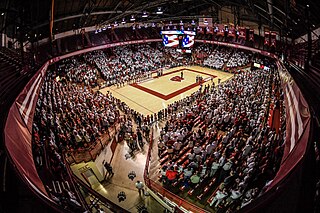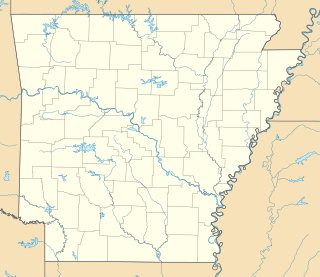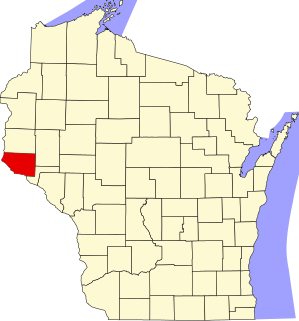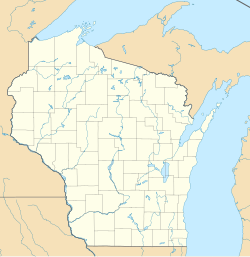
The University of Wisconsin Oshkosh is a public university in Oshkosh, Wisconsin. It is part of the University of Wisconsin System and offers bachelor's, master's, and doctoral degree programs to nearly 14,000 students each year.

Pfeiffer University is a private university in Misenheimer, North Carolina. It is affiliated with the United Methodist Church.

The Wisconsin Field House is a multi-purpose arena owned by the University of Wisconsin–Madison and located directly south of Camp Randall Stadium. In addition to sports events, the Field House has been the site of large community gatherings such as convocations and concerts. It was added to the National Register of Historic Places in 1998.

Bascom Hill is the main quadrangle that forms the symbolic core of the University of Wisconsin–Madison campus. It is located on the opposite end of State Street from the Wisconsin State Capitol, and is named after John Bascom, former president of the University of Wisconsin. The hill itself is a drumlin, formed by glacial deposits about 18,000 years ago.
This is an incomplete list of historic properties and districts at United States colleges and universities that are listed on the National Register of Historic Places (NRHP). This includes National Historic Landmarks (NHLs) and other National Register of Historic Places listings. It includes listings at current and former educational institutions.

North Hall, University of Wisconsin was the first structure on the University of Wisconsin campus. Located on Bascom Hill, it was built in 1851 at a cost of $19,000. John Muir resided in North Hall when he was a student at the University from 1860 to 1863. It currently houses the offices of the political science faculty at the university. Muir knoll, across the street, was home to the first American university ski tournament in 1920.

The University of Wisconsin Armory and Gymnasium, also called "the Red Gym" or “Bowser’s Castle,” is a building on the campus of University of Wisconsin–Madison. It was originally used as a combination gymnasium and armory beginning in 1894. Designed in the Romanesque revival style, it resembles a red brick castle. It is situated on the shores of Lake Mendota, overlooking Library Mall, and adjacent to Memorial Union.

University of Wisconsin Science Hall is a building on the campus of the University of Wisconsin–Madison. It is significant for its association with Charles R. Van Hise, "who led the Department of Mineralogy and Geology to national prominence" and then served as president of the university. The building was constructed in 1888. It was declared a National Historic Landmark in 1993.

The University of Wisconsin Dairy Barn is a building located on the campus of the University of Wisconsin–Madison. Built in 1897, the building played an important role in the field of dairy science during the 20th century. It has been used both as a teaching facility and as a site for agricultural research. It is significant for its association with the single-grain experiment, performed from 1907 to 1911 by Stephen Babcock. The UW Dairy Barn was declared a National Historic Landmark in 2005.

Racine College was an Episcopal preparatory school and college in Racine, Wisconsin, that operated between 1852 and 1933. Located south of the city along Lake Michigan, the campus has been maintained and is today known as the DeKoven Center, a conference center operated by the Community of St. Mary via the DeKoven Foundation.

The Sioux Quartzite is a Proterozoic quartzite that is found in the region around the intersection of Minnesota, South Dakota, and Iowa, and correlates with other rock units throughout the upper midwestern and southwestern United States. It was formed by braided river deposits, and its correlative units are thought to possibly define a large sedimentary wedge that once covered the passive margin on the then-southern side of the North American craton. In human history, it provided the catlinite, or pipestone, that was used by the Plains Indians to carve ceremonial pipes. With the arrival of Europeans, it was heavily quarried for building stone, and was used in many prominent structures in Sioux Falls, South Dakota and shipped to construction sites around the Midwest. Sioux Quartzite has been and continues to be quarried in Jasper, Minnesota at the Jasper Stone Company and Quarry, which itself was posted to the National Register of Historic Places on January 5, 1978. Jasper, Minnesota contains many turn-of-the-century quartzite buildings, including the school, churches and several other public and private structures, mostly abandoned.

Deveaux School Historic District is a national historic district located at Niagara Falls in Niagara County, New York.

The University of Arkansas Campus Historic District is a historic district that was listed on the National Register of Historic Places on September 23, 2009. The district covers the historic core of the University of Arkansas campus, including 25 buildings.

Main Hall is an academic building on the campus of Lawrence University in Appleton, Wisconsin. Constructed in 1853, it was listed on the National Register of Historic Places in 1974.

This is a list of the National Register of Historic Places listings in Pierce County, Wisconsin. It is intended to provide a comprehensive listing of entries in the National Register of Historic Places that are located in Pierce County, Wisconsin. The locations of National Register properties for which the latitude and longitude coordinates are included below may be seen in a map.
Peter J. Williamson was a Dutch-American architect.

North Hall is located on the campus of what is now the University of Wisconsin-River Falls. It was added to the National Register of Historic Places in 1986.

The Hector F. DeLuca Biochemistry Building, originally known as the Agricultural Chemistry Building, is a historic structure on the campus of the University of Wisconsin–Madison. It was the site of the discovery of vitamins A and B, as well as the development of vitamin D processing.

Ullrich Hall is a historic building on the campus of University of Wisconsin-Platteville in Platteville, Wisconsin.



















